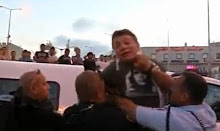Global Research
Patrick Martin
The shooting down of a US Chinook helicopter early Saturday morning in Afghanistan killed 38 soldiers, including 30 Americans and eight Afghans. Among the dead were 22 Navy SEALs, an elite special forces squad. Seven helicopter crew members and air combat controllers, a dog handler, seven Afghan soldiers and an Afghan interpreter died along with the SEALs.
According to press reports citing unnamed military sources, the SEALs were called in for a rescue operation after a small unit of US special forces, from the Army Rangers, was pinned down by Taliban fighters. The SEALs flew in on the helicopter and drove off the Taliban attackers, killing eight of them. They had just reboarded the helicopter for the return flight when a rocket-propelled grenade or surface-to-air missile hit the Chinook and destroyed it in mid-air.
A conflicting account of the attack, also citing military sources, suggested that the Taliban fighters were killed after the helicopter was shot down, not before, when a second US helicopter-borne special forces unit landed, attacked the Taliban, and then sought to retrieve the bodies and the wreckage.
Saturday’s disaster reproduces exactly the pattern of the previous worst tactical defeat for US forces in the war, when a US helicopter was shot down in Kunar province in June 2005, killing 16 soldiers. Those troops were also engaged in a rescue operation for a smaller group of special forces who were surrounded and ultimately killed by Taliban fighters.
Accounts by residents of the Tangi valley in Wardak province, interviewed by McClatchy News Service, contradicted both military versions. They said that the helicopter was shot down before it could land, by Taliban fighters who had been given advance warning of the night raid and were on the alert against it.
The Los Angeles Times reported, “In a statement Saturday, the Taliban claimed its fighters had ambushed Western troops after being tipped off to an imminent night raid in the district. If true, that would amount to a devastating breach of U.S. operational security. The Taliban statement, from spokesman Zabiullah Mujahid, was unusually specific in some of its details, including the number of troops killed—even before Afghan officials released the number.”
Whatever the exact sequence of events, the military disaster—the single worst loss of life for US forces in the 10 years of warfare—was a direct outcome of the escalation of special forces operations throughout Afghanistan.
Some 10,000 of the 100,000 US troops deployed in Afghanistan are drawn from various special forces commands. They serve as the spearhead of what the media call “counterterrorism” operations—although the campaign would be better described as the systematic assassination of suspected opponents of the US occupation and its stooge president, Hamid Karzai.
The Obama administration is investing more and more heavily in such actions to prop up the unpopular Karzai regime and deplete the ranks of the guerrilla forces fighting the US-NATO occupation. In the second quarter of the year, according to NATO figures, special forces troops conducted 2,832 night raids, double the number during the same period a year ago, killing 834 insurgents and capturing 2,941.
Officials in Kabul and Washington issued statements denying that the incident represented a significant tactical or strategic setback for the US military intervention in Afghanistan, but this posture is belied by the scale of the disaster—the loss of nearly 10 percent of the total manpower of SEAL Team 6, estimated in press accounts as 250 to 300 men.
The losses were the greatest inflicted on Navy special forces since World War II. Each commando is the product of a five-year training program, making the losses that much more difficult to replace. SEAL Team 6 was the unit that carried out the assassination of Osama bin Laden in Pakistan May 2, though US officials claimed that none of those involved in that attack was killed in Wardak.
The location of the disaster also demonstrates the deepening crisis of the US occupation regime. Wardak province borders on Kabul, and the Tangi Valley has served as a key infiltration route into the capital region for Taliban fighters.
Despite the escalation of the US military effort over the past three years, since Obama entered the White House, the anti-occupation forces remain well entrenched in Wardak, only 50 miles from Kabul.
According to a McClatchy News account, headlined, “Valley where US troops died backs Taliban,” the increasing frequency of night raids and assassinations by US forces has deeply alienated the local population.
Roshanak Wardak, a doctor and former member of parliament, told McClatchy the raids occur “every night. We are very much miserable.” Another doctor told the news service, “The Americans are committing barbaric acts in the area and this is the reason that the Taliban have influence.”
A local villager, Abdul Rehman Barakzai, said that as many as three civilians were killed in a US raid in the area the night before the shooting down of the helicopter. He added, “The Taliban are so active in the region that they forced the Americans to abandon a base here about two or three months ago because the base was under attack day and night. The area ... is completely under the control of the Taliban.”
Another villager told McClatchy that the anti-US insurgency was broadly based in the province. “From each house at least one person is with the Taliban,” he said.
A separate US news account confirmed this general assessment, citing the statement of a US Army intelligence officer in the Tangi valley, “It’s a stronghold for the Taliban.”
Shahidullah Shahid, a spokesman for the governor of Wardak, confirmed this account, telling the Washington Post, “The Americans left because they were getting casualties with each operation ... and since then, the insurgents have increased their activity.”
The British daily newspaper Guardian raised an even more disturbing prospect—from the standpoint of American and British imperialism—raised by the helicopter shootdown.
The newspaper said that NATO investigators “will want to discover whether the aircraft was downed by a lucky shot from a rocket-propelled grenade, a highly inaccurate weapon, or by something more sophisticated,” like Manpad surface-to-air missile systems.” It added: “Classified military reports released by WikiLeaks last year showed that the US military covered up a reported surface-to-air missile strike that downed a Chinook helicopter over Helmand, killing seven soldiers.”
The US decision to supply surface-to-air missiles to the Afghan mujahedin guerrillas in the 1980s played a critical role in defeating the military intervention by the Soviet Union. Similar weapons could be supplied to today’s Afghan insurgents through Pakistan.
The crash Saturday brings the total number of US troops killed in Afghanistan this year to 274, and the total deaths for all NATO forces in Afghanistan to 379, including 42 in August. On Sunday, another four soldiers were added to this mounting toll, with the NATO command reporting two deaths in the east and two in the south, but giving no additional details.
Meanwhile, the bloodbath by the occupation military and their puppet forces against Afghan civilians continues uninterrupted. On Friday, Afghan police shot and killed four people during a protest march in the south, sparked by killings by NATO forces in an overnight raid.
On Saturday, NATO troops attacked a house in Helmand province and “inadvertently” killed a woman and her seven small children, all seven years old or younger, according to an Afghan government statement. The intended target of the raid, a Taliban organizer, was not in the house at the time.
Patrick Martin
The shooting down of a US Chinook helicopter early Saturday morning in Afghanistan killed 38 soldiers, including 30 Americans and eight Afghans. Among the dead were 22 Navy SEALs, an elite special forces squad. Seven helicopter crew members and air combat controllers, a dog handler, seven Afghan soldiers and an Afghan interpreter died along with the SEALs.
According to press reports citing unnamed military sources, the SEALs were called in for a rescue operation after a small unit of US special forces, from the Army Rangers, was pinned down by Taliban fighters. The SEALs flew in on the helicopter and drove off the Taliban attackers, killing eight of them. They had just reboarded the helicopter for the return flight when a rocket-propelled grenade or surface-to-air missile hit the Chinook and destroyed it in mid-air.
A conflicting account of the attack, also citing military sources, suggested that the Taliban fighters were killed after the helicopter was shot down, not before, when a second US helicopter-borne special forces unit landed, attacked the Taliban, and then sought to retrieve the bodies and the wreckage.
Saturday’s disaster reproduces exactly the pattern of the previous worst tactical defeat for US forces in the war, when a US helicopter was shot down in Kunar province in June 2005, killing 16 soldiers. Those troops were also engaged in a rescue operation for a smaller group of special forces who were surrounded and ultimately killed by Taliban fighters.
Accounts by residents of the Tangi valley in Wardak province, interviewed by McClatchy News Service, contradicted both military versions. They said that the helicopter was shot down before it could land, by Taliban fighters who had been given advance warning of the night raid and were on the alert against it.
The Los Angeles Times reported, “In a statement Saturday, the Taliban claimed its fighters had ambushed Western troops after being tipped off to an imminent night raid in the district. If true, that would amount to a devastating breach of U.S. operational security. The Taliban statement, from spokesman Zabiullah Mujahid, was unusually specific in some of its details, including the number of troops killed—even before Afghan officials released the number.”
Whatever the exact sequence of events, the military disaster—the single worst loss of life for US forces in the 10 years of warfare—was a direct outcome of the escalation of special forces operations throughout Afghanistan.
Some 10,000 of the 100,000 US troops deployed in Afghanistan are drawn from various special forces commands. They serve as the spearhead of what the media call “counterterrorism” operations—although the campaign would be better described as the systematic assassination of suspected opponents of the US occupation and its stooge president, Hamid Karzai.
The Obama administration is investing more and more heavily in such actions to prop up the unpopular Karzai regime and deplete the ranks of the guerrilla forces fighting the US-NATO occupation. In the second quarter of the year, according to NATO figures, special forces troops conducted 2,832 night raids, double the number during the same period a year ago, killing 834 insurgents and capturing 2,941.
Officials in Kabul and Washington issued statements denying that the incident represented a significant tactical or strategic setback for the US military intervention in Afghanistan, but this posture is belied by the scale of the disaster—the loss of nearly 10 percent of the total manpower of SEAL Team 6, estimated in press accounts as 250 to 300 men.
The losses were the greatest inflicted on Navy special forces since World War II. Each commando is the product of a five-year training program, making the losses that much more difficult to replace. SEAL Team 6 was the unit that carried out the assassination of Osama bin Laden in Pakistan May 2, though US officials claimed that none of those involved in that attack was killed in Wardak.
The location of the disaster also demonstrates the deepening crisis of the US occupation regime. Wardak province borders on Kabul, and the Tangi Valley has served as a key infiltration route into the capital region for Taliban fighters.
Despite the escalation of the US military effort over the past three years, since Obama entered the White House, the anti-occupation forces remain well entrenched in Wardak, only 50 miles from Kabul.
According to a McClatchy News account, headlined, “Valley where US troops died backs Taliban,” the increasing frequency of night raids and assassinations by US forces has deeply alienated the local population.
Roshanak Wardak, a doctor and former member of parliament, told McClatchy the raids occur “every night. We are very much miserable.” Another doctor told the news service, “The Americans are committing barbaric acts in the area and this is the reason that the Taliban have influence.”
A local villager, Abdul Rehman Barakzai, said that as many as three civilians were killed in a US raid in the area the night before the shooting down of the helicopter. He added, “The Taliban are so active in the region that they forced the Americans to abandon a base here about two or three months ago because the base was under attack day and night. The area ... is completely under the control of the Taliban.”
Another villager told McClatchy that the anti-US insurgency was broadly based in the province. “From each house at least one person is with the Taliban,” he said.
A separate US news account confirmed this general assessment, citing the statement of a US Army intelligence officer in the Tangi valley, “It’s a stronghold for the Taliban.”
Shahidullah Shahid, a spokesman for the governor of Wardak, confirmed this account, telling the Washington Post, “The Americans left because they were getting casualties with each operation ... and since then, the insurgents have increased their activity.”
The British daily newspaper Guardian raised an even more disturbing prospect—from the standpoint of American and British imperialism—raised by the helicopter shootdown.
The newspaper said that NATO investigators “will want to discover whether the aircraft was downed by a lucky shot from a rocket-propelled grenade, a highly inaccurate weapon, or by something more sophisticated,” like Manpad surface-to-air missile systems.” It added: “Classified military reports released by WikiLeaks last year showed that the US military covered up a reported surface-to-air missile strike that downed a Chinook helicopter over Helmand, killing seven soldiers.”
The US decision to supply surface-to-air missiles to the Afghan mujahedin guerrillas in the 1980s played a critical role in defeating the military intervention by the Soviet Union. Similar weapons could be supplied to today’s Afghan insurgents through Pakistan.
The crash Saturday brings the total number of US troops killed in Afghanistan this year to 274, and the total deaths for all NATO forces in Afghanistan to 379, including 42 in August. On Sunday, another four soldiers were added to this mounting toll, with the NATO command reporting two deaths in the east and two in the south, but giving no additional details.
Meanwhile, the bloodbath by the occupation military and their puppet forces against Afghan civilians continues uninterrupted. On Friday, Afghan police shot and killed four people during a protest march in the south, sparked by killings by NATO forces in an overnight raid.
On Saturday, NATO troops attacked a house in Helmand province and “inadvertently” killed a woman and her seven small children, all seven years old or younger, according to an Afghan government statement. The intended target of the raid, a Taliban organizer, was not in the house at the time.































Now, I'm only saying this to be somewhat critical. I respect these men greatly. I'd like to point out that Navy SEALs are not a Special Forces squad, there is only one Special Forces, and that is the Army: Special Forces, also known as the Green Berets. What you probably mean is Special Operations Forces.
ReplyDeleteAnd I'd also like to point out that the Combat Controller trains on a level higher than Navy SEALs, and so leaving him out of that pictures is a bit baffling to me. I'm serious about that, go look it up.
Otherwise, thank you for writing this article. I hope my information can help you in the future.